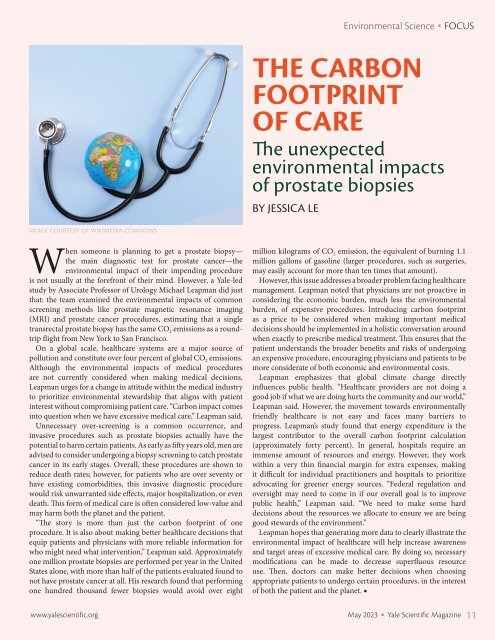YSM Issue 96.2
Create successful ePaper yourself
Turn your PDF publications into a flip-book with our unique Google optimized e-Paper software.
Environmental Science<br />
FOCUS<br />
THE CARBON<br />
FOOTPRINT<br />
OF CARE<br />
The unexpected<br />
environmental impacts<br />
of prostate biopsies<br />
BY JESSICA LE<br />
IMAGE COURTESY OF WIKIMEDIA COMMONS<br />
When someone is planning to get a prostate biopsy—<br />
the main diagnostic test for prostate cancer—the<br />
environmental impact of their impending procedure<br />
is not usually at the forefront of their mind. However, a Yale-led<br />
study by Associate Professor of Urology Michael Leapman did just<br />
that: the team examined the environmental impacts of common<br />
screening methods like prostate magnetic resonance imaging<br />
(MRI) and prostate cancer procedures, estimating that a single<br />
transrectal prostate biopsy has the same CO 2 emissions as a roundtrip<br />
flight from New York to San Francisco.<br />
On a global scale, healthcare systems are a major source of<br />
pollution and constitute over four percent of global CO 2 emissions.<br />
Although the environmental impacts of medical procedures<br />
are not currently considered when making medical decisions,<br />
Leapman urges for a change in attitude within the medical industry<br />
to prioritize environmental stewardship that aligns with patient<br />
interest without compromising patient care. “Carbon impact comes<br />
into question when we have excessive medical care,” Leapman said.<br />
Unnecessary over-screening is a common occurrence, and<br />
invasive procedures such as prostate biopsies actually have the<br />
potential to harm certain patients. As early as fifty years old, men are<br />
advised to consider undergoing a biopsy screening to catch prostate<br />
cancer in its early stages. Overall, these procedures are shown to<br />
reduce death rates; however, for patients who are over seventy or<br />
have existing comorbidities, this invasive diagnostic procedure<br />
would risk unwarranted side effects, major hospitalization, or even<br />
death. This form of medical care is often considered low-value and<br />
may harm both the planet and the patient.<br />
“The story is more than just the carbon footprint of one<br />
procedure. It is also about making better healthcare decisions that<br />
equip patients and physicians with more reliable information for<br />
who might need what intervention,” Leapman said. Approximately<br />
one million prostate biopsies are performed per year in the United<br />
States alone, with more than half of the patients evaluated found to<br />
not have prostate cancer at all. His research found that performing<br />
one hundred thousand fewer biopsies would avoid over eight<br />
www.yalescientific.org<br />
million kilograms of CO 2 emission, the equivalent of burning 1.1<br />
million gallons of gasoline (larger procedures, such as surgeries,<br />
may easily account for more than ten times that amount).<br />
However, this issue addresses a broader problem facing healthcare<br />
management. Leapman noted that physicians are not proactive in<br />
considering the economic burden, much less the environmental<br />
burden, of expensive procedures. Introducing carbon footprint<br />
as a price to be considered when making important medical<br />
decisions should be implemented in a holistic conversation around<br />
when exactly to prescribe medical treatment. This ensures that the<br />
patient understands the broader benefits and risks of undergoing<br />
an expensive procedure, encouraging physicians and patients to be<br />
more considerate of both economic and environmental costs.<br />
Leapman emphasizes that global climate change directly<br />
influences public health. “Healthcare providers are not doing a<br />
good job if what we are doing hurts the community and our world,”<br />
Leapman said. However, the movement towards environmentally<br />
friendly healthcare is not easy and faces many barriers to<br />
progress. Leapman’s study found that energy expenditure is the<br />
largest contributor to the overall carbon footprint calculation<br />
(approximately forty percent). In general, hospitals require an<br />
immense amount of resources and energy. However, they work<br />
within a very thin financial margin for extra expenses, making<br />
it difficult for individual practitioners and hospitals to prioritize<br />
advocating for greener energy sources. “Federal regulation and<br />
oversight may need to come in if our overall goal is to improve<br />
public health,” Leapman said. “We need to make some hard<br />
decisions about the resources we allocate to ensure we are being<br />
good stewards of the environment.”<br />
Leapman hopes that generating more data to clearly illustrate the<br />
environmental impact of healthcare will help increase awareness<br />
and target areas of excessive medical care. By doing so, necessary<br />
modifications can be made to decrease superfluous resource<br />
use. Then, doctors can make better decisions when choosing<br />
appropriate patients to undergo certain procedures, in the interest<br />
of both the patient and the planet. ■<br />
May 2023 Yale Scientific Magazine 11

















